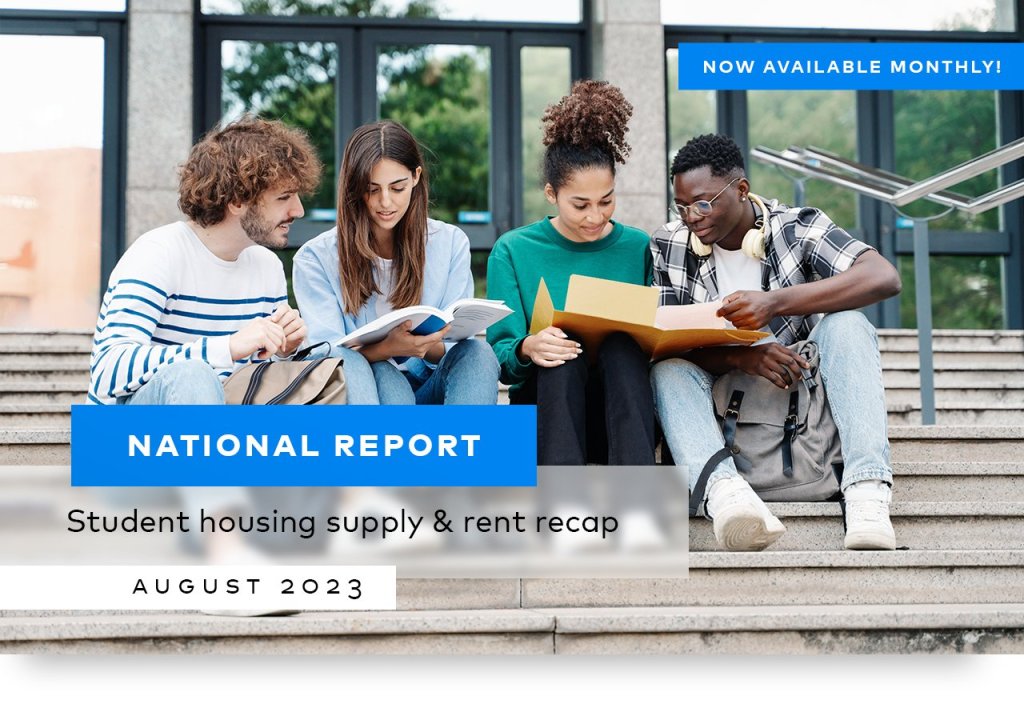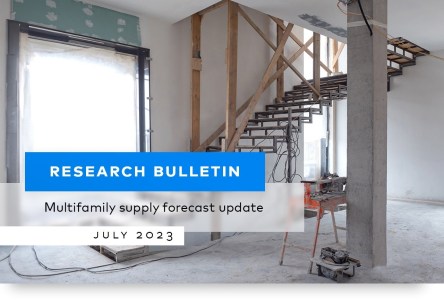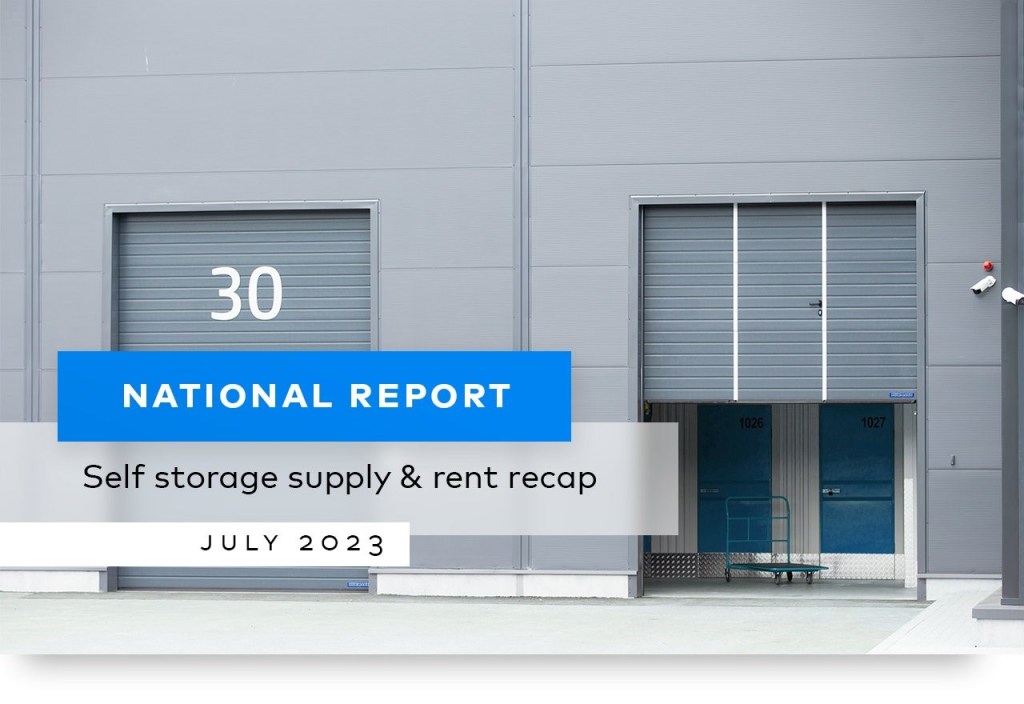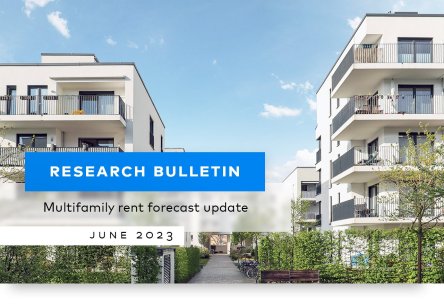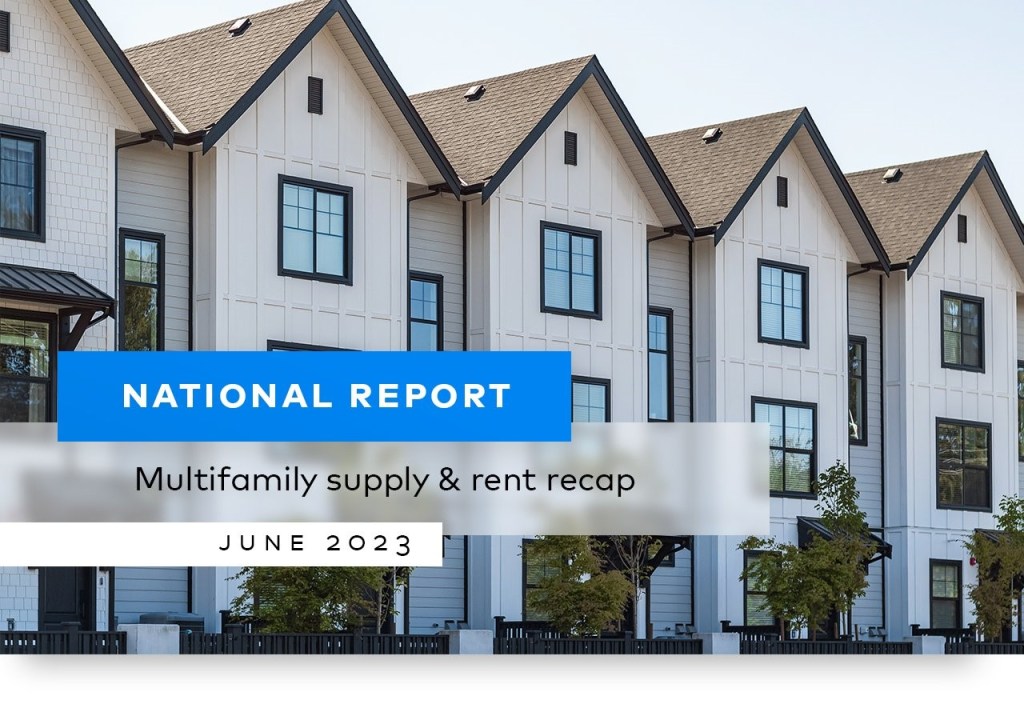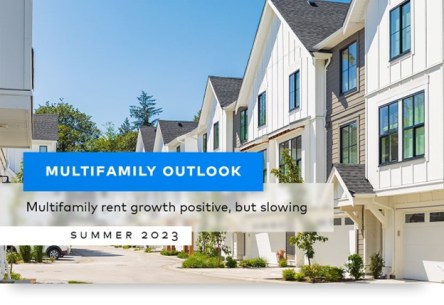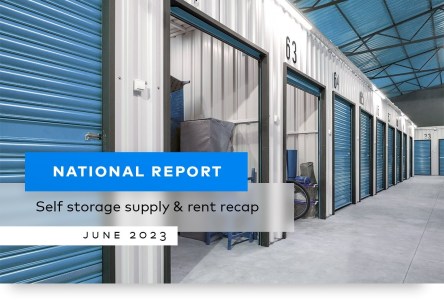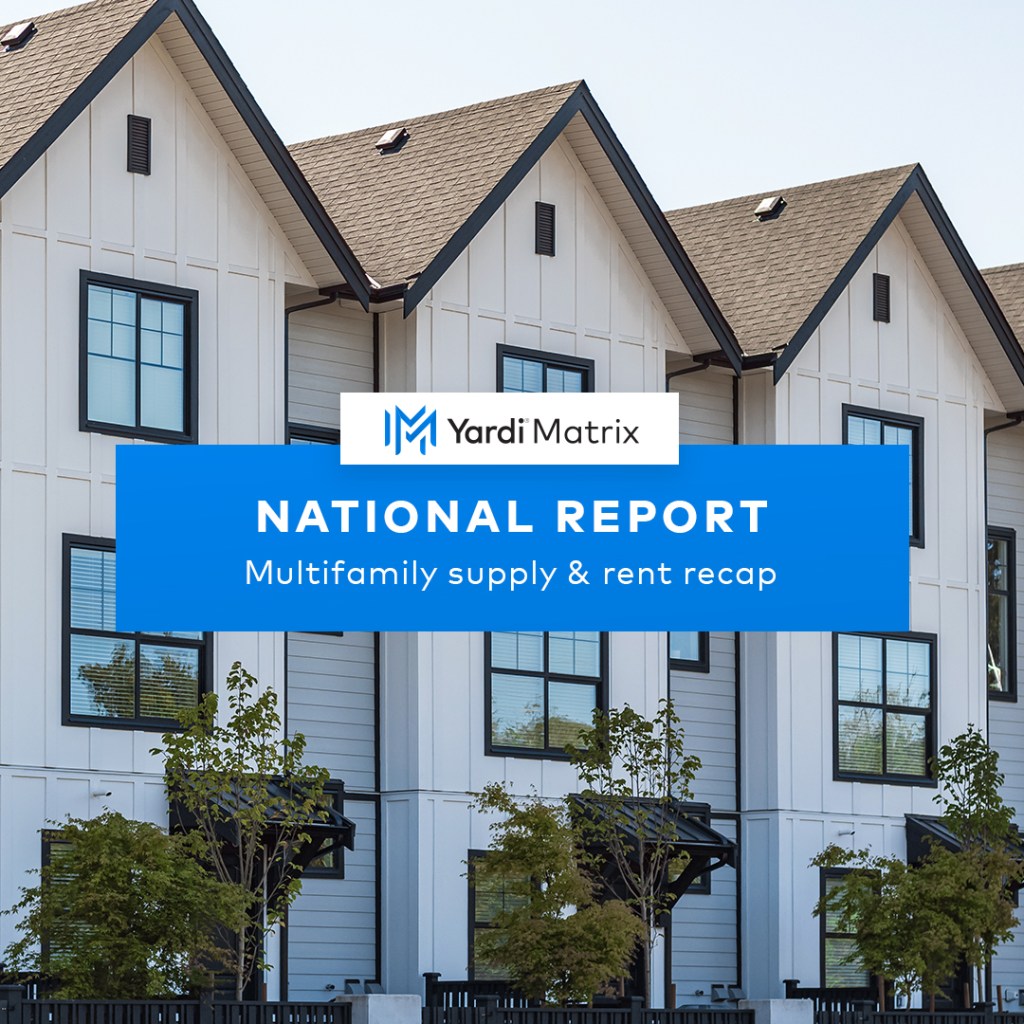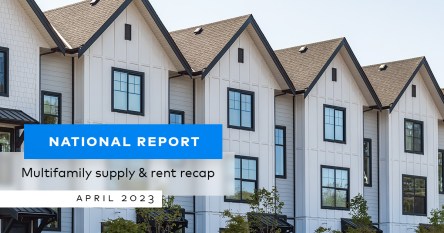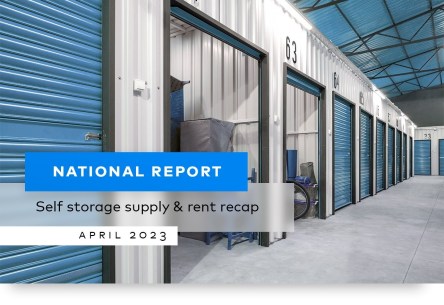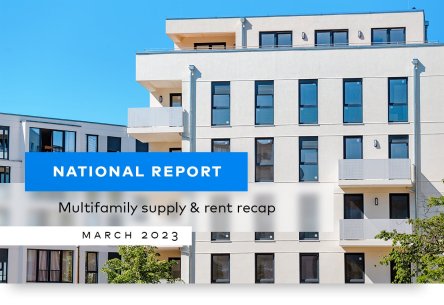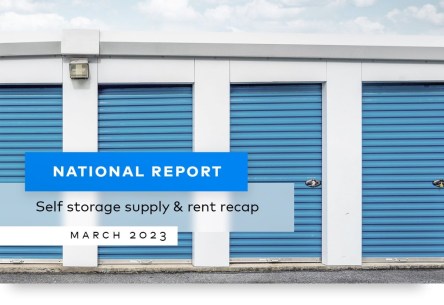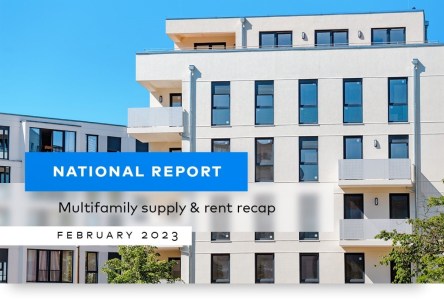The student housing sector continues to outperform as the Fall 2023 school year approaches, according to the August National Student Housing Report from Yardi Matrix. Reports on national student housing performance, with insight on preleasing and rental rates, are now being delivered on a monthly basis. As of July, 90.1 percent of beds at Yardi 200 universities were preleased for the upcoming fall term, a 4.6 percent increase from the prior month and about even with last year. Preleasing was near a record high for July, and year-over-year rent growth throughout the leasing season has been ahead of last year. The sector is equipped to handle economic challenges, with solid occupancy and rent growth for the 2023-2024 school year and counter-cyclical demand. “Preleasing has slowed recently from rapid growth at the beginning of the leasing season. Month-over-month rent growth has also decelerated,” states the report. Despite the drop, fall occupancy is projected to match last year at around 96 percent, while rent growth remains impressive at 7.1 percent year-over-year. Strong fundamentals continue to fuel development, and Yardi Matrix projects approximately 40,000 new beds will be delivered in Fall 2023 at Yardi 200 universities, compared to 27,000 delivered last fall. Solid preleasing and rent growth suggests that much of the supply has already been absorbed. The student housing data set includes over 2,000 universities and colleges nationwide, including the top 200 investment grade universities across all major collegiate conferences. Known as the “Yardi 200,” it includes all Power 5 conferences as well as Carnegie R1 and R2 universities. Gain more insight in the latest Student Housing Report. Future reports will include a rotating special topic such as enrollment trends, transaction volume or development activity. Yardi Matrix covers multifamily, student housing, industrial, office, retail, vacant land and self storage property types. Email [email protected], call (480) 663-1149 or visit yardimatrix.com to learn...
Supply Forecast
Improves for Multifamily
The multifamily housing supply could increase to nearly seven percent by the end of 2023, states the latest Multifamily Supply Forecast from Yardi Matrix. The Q3 2023 supply forecast update has increased forecast completions 6.9 percent for 2023 and 6.5 percent for 2024. The near-term forecast was increased this month as the under-construction pipeline continues to expand, and 2023 construction starts to date have not exhibited any signs of a slowdown. For multifamily markets tracked on or before January 2020, there are currently just over 1.1M units under construction. Of these units, 429,626 are currently in lease-up, roughly in line with the trailing 12-month average of 421,000 units. Most of these units will complete in 2023 or the first half of 2024. As of this report’s release, Yardi Matrix is tracking 688,420 under-construction units that are not in lease-up. This represents a 36.9 percent year-over-year increase and a 96.7 percent increase over pre-pandemic levels. The longer-term supply forecast accounts for depressing completions in 2025 and 2026 relative to current levels, with a rebound taking hold in 2027. Forecast completions for 2026 have been reduced by five percent to 401,065, while forecast 2027 and 2028 completions have been reduced to 417,378 and 426,722 units, respectively. Review the latest Multifamily Supply Forecast here. Yardi Matrix offers the industry’s most comprehensive market intelligence tool for investment professionals, equity investors, lenders and property managers who underwrite and manage investments in commercial real estate. Yardi Matrix covers multifamily, student housing, industrial, office and self storage property types. Email [email protected], call (480) 663-1149 or visit yardimatrix.com to learn...
Self Storage Stalls
Yardi Matrix Reports
Responding to moderating demand, self storage street rates remained healthy through the second quarter of 2023, according to the latest National Self Storage Report from Yardi Matrix. Nationally, the average rate for self storage units overall remained unchanged month-over-month. Historically, rates tend to increase in the summer months. With the exception of 2019, every year from 2017 to 2022 experienced a May-to-June rent increase of at least 0.7 percent. “Muted monthly rate growth this year may signal that move-ins are slowing this leasing season as demand cools,” say Matrix analysts. “Move-in activity has slowed this year as home sales have cooled, especially compared to the robust home sales in early 2022.” In June, national street rates for 10×10 NON CC units decreased 3.8 percent year-over-year. Rates for 10×10 CC units fared worse, falling 5.3 percent year-over-year, the largest recorded decline since May 2020. Annual street rate growth continued to be negative for almost all of Yardi Matrix’s top 31 metros in June. Street rates for 10×10 NON CC units were down year-over-year in 97 percent of the top 31 metros. Learn more about the state of the self storage sector nationwide. Yardi Matrix tracks a total of 4,751 self storage properties in various stages of development, including 810 under construction, 1,913 planned, 622 prospective, 1,353 abandoned and 53 deferred. Matrix also maintains operational profiles for 29,824 completed self storage facilities across the United States, bringing the total data set to 34,575. Yardi Matrix offers the industry’s most comprehensive market intelligence tool for investment professionals, equity investors, lenders and property managers who underwrite and manage investments in commercial real estate. Yardi Matrix covers multifamily, student housing, industrial, office and self storage property types. Email [email protected], call (480) 663-1149 or visit yardimatrix.com to learn...
Forecast Adjusted
For Multifamily
Market corrections in Florida and California contributed to a month-over-month increase of average asking rents nationally by 41 basis points in May, states the latest Multifamily Forecast from Yardi Matrix. It was a decrease from the 44-basis-point MoM increase recorded in April and was prompted by actual decreases in asking rents in two regions: Florida markets that saw unbelievable growth during the pandemic and now face affordability problems, and California cities still struggling to find their post-pandemic footing. Five of the 10 worst-performing markets were in Florida (Southwest Florida Coast, Miami, Orlando, Jacksonville and West Palm Beach), and of the remaining markets that saw month-over-month declines, six were in California (metro Los Angeles, Sacramento, Eastern Los Angeles County, the East Bay, Orange County and the Inland Empire). Strong growth continues in many Midwestern and Northeastern markets: Portland, Maine, and Scranton–Wilkes-Barre both grew more than a full percentage point month-over-month. White Plains, Detroit, Urban and Suburban Chicago, Manhattan, Milwaukee, Rochester, Central New Jersey and Syracuse all saw asking rents grow more than 90 basis points from the previous month. The average apartment asking rent nationally was $1,726 in June, according to the Yardi Matrix National Multifamily Report. The update forecast lowers rent rate expectations for many larger markets in the West and Southwest and raises them for many midsize markets throughout the Midwest, Northeast and parts of the South. “The stalled-out return-to-office movement is putting a significant drag on Western markets with large numbers of knowledge-based workers, and economic uncertainty will continue to limit demand in those markets that have largely been driven by high-paying tech jobs,” states the report. As for those cities whose outlook improved: “As affordability continues to be a concern across the country and economic uncertainty prevails, these smaller markets will...
New Rent Record
For Student Housing
The student housing sector continues to record strong rent growth and preleasing performance is up slightly over 2022, according to the latest National Student Housing Report from Yardi Matrix. As of June, 86.6 percent of beds at Yardi 200 universities were preleased for the upcoming fall term, a 5.2 percent increase from the prior month. June also marked the fifth consecutive month of annual rent growth over seven percent at Yardi 200 universities, at 7.2 percent. Given that 2022 held the previous rent record for student housing, obtaining more than seven percent growth off of previous record-high numbers is exceptional. The average rent per bed at Yardi 200 universities was $846 at quarter-end, a new all-time record. “Under the surface of solid overall fundamentals at the Yardi 200 level is mixed performance at individual schools, as some universities are doing exceptionally well while others fall short. Performance at the university level is mainly correlated to local supply-and-demand dynamics rather than higher-level trends,” state Matrix analysts. The student housing data set includes over 2,000 universities and colleges nationwide, including the top 200 investment grade universities across all major collegiate conferences. Known as the “Yardi 200,” it includes all Power 5 conferences as well as Carnegie R1 and R2 universities. However, the sector isn’t totally unscathed by current economic conditions. Transaction volume through the second quarter was down about 73 percent from the same time last year, a stark reminder of weakening economic sentiment. But that hasn’t slowed the off-campus dedicated student housing development pipeline, which expanded by approximately 28,000 bedrooms since January. Gain more insight in the latest Student Housing Report. Yardi Matrix covers multifamily, student housing, industrial, office and self storage property types. Email [email protected], call (480) 663-1149 or visit yardimatrix.com to learn...
Multifamily Rent Update
From Yardi Matrix
Multifamily asking rents grew another $7 last month, on average, but year-over-year growth fell to 1.8 percent, according to the latest Yardi Matrix National Multifamily Report. That’s down 70 basis points from May. Rents are buoyed by ongoing strong demand for units. Though down from the 2021 highs, occupancy rates are steady at 95 percent. The average asking rent was $1,726 in June. “Rents are growing within a normal seasonal pattern, albeit well below the post-pandemic boom and even below pre-pandemic trends,” say analysts. Rents were up $20, or 1.2 percent, in the second quarter, and are up $23, or 1.4 percent, during the first half of 2023. Single-family rental rates increased $5 in June to $2,103, while year-over-year growth fell 80 basis points to 1.3 percent. “Demand has remained strong, driven by the job market, which added 1.5 million jobs during the first half of 2023, and weak home sales, which are presenting a challenge to first-time home buyers,” states the report. A growing number of metros are now posting negative growth year-over-year, states the report. Nine of the 30 metros tracked by Matrix were negative in June, mostly in the Sun Belt and West, where demand has reverted to normal as new supply comes online. This month’s report includes an updated list of metros that will be of interest to multifamily investors, owners and managers. Gain more insight in the new Yardi Matrix National Multifamily Report. Yardi Matrix offers the industry’s most comprehensive market intelligence tool for investment professionals, equity investors, lenders and property managers who underwrite and manage investments in commercial real estate. Yardi Matrix covers multifamily, student housing, industrial, office and self storage property types. Email [email protected], call (480) 663-1149 or visit yardimatrix.com to learn...
Multifamily Outlook
Insight from Yardi Matrix
Multifamily rents continued to increase through the first half of 2023, despite challenges for the sector and continuing economic uncertainty. But job growth has remained robust and new households keep forming, creating apartment demand and ongoing rent growth. “We anticipate that rents will continue to increase modestly over the course of the year as demand has firmed, albeit at a more moderate rate in line with historic growth levels,” say Yardi Matrix experts in a newly released U.S. Multifamily Outlook. Through the first five months of 2023, U.S. asking rents rose $17, or 0.9 percent, with year-over-year growth falling to 2.6 percent. “We expect continued deceleration, with rent growth of 2.5 percent for the full year,” states the outlook. The average U.S. apartment rent reached an all-time high of $1,716 in May. Challenges for the sector include slowing demand, growing issues with affordability, slower population growth and competition from a large number of new units coming online through 2024. The capital side of the industry has suffered due to heightened interest rates, which show little sign of decreasing in the near-term. Property values are down 15-20 percent from their peak and are still declining due to the higher cost of capital. New deliveries will be high at least through the end of 2024, as the 1 million units under construction come online. New starts are now declining, however, because debt is more expensive and fewer banks are financing construction. Household formation, which drove the 22 percent cumulative growth in U.S. asking rents over 2021 and 2022, has slowed but remains positive. Although some pandemic demographic trends are moderating, the desire for more space to balance living, working and family appears to have staying power and should continue to drive demand. Demand is also boosted...
Storage Rates Hold
Yardi Matrix Report
Self storage street rates were solid in May, with several unit types and sizes improving on a monthly basis and sequential growth staying to trend, according to the latest National Self Storage Report from Yardi Matrix. The self storage market continues to be resilient, despite headwinds to demand caused by a slowing housing market. National street rates for standard-size 10×10 non-climate-controlled (NON CC) units and 10×10 climate-controlled (CC) units both increased $1 month-over-month in May, to $128 and $143, respectively. Across all rate types tracked by Yardi Matrix, smaller-size units performed the strongest in May, as national rates for 5×5 units increased 1.8 percent for NON CC units and 1.7 percent for CC units on a monthly basis. Year-over-year, national street rates for 10×10 NON CC units decreased 3.8 percent, while rates for 10×10 CC units fell by 4.7 percent. Although year-over-year street rate growth has turned negative, net operating income continues to increase as operators push rates. That has come at the cost of a slight hit to occupancy rates, but demand is still above pre-pandemic levels. “The outlook for the sector remains optimistic, although concerns persist about how the slowdown in home sales and potential weakening job market caused by higher interest rates will impact storage demand, street rates and occupancy levels in the second half of 2023,” state Matrix experts. Learn more about the state of the self storage sector nationwide. Yardi Matrix tracks a total of 4,799 self storage properties nationwide in various stages of development — including 807 under construction, 1,959 planned and 646 prospective properties. Matrix also maintains operational profiles for 29,744 completed self storage facilities across the United States, bringing the total data set to 34,543. Yardi Matrix offers the industry’s most comprehensive market intelligence tool for investment...
Rents Rise in May
Multifamily Update
Multifamily asking rents rose for the third straight month in May, according to the latest National Multifamily Report from Yardi Matrix. Despite the threat of a slowing economy looming, average U.S. asking rent rose $7 in May to $1,716, while year-over-year growth decelerated to 2.6 percent. That was the lowest level since March 2021. For the year to date, rents are up $18, or one percent since January 1. The seasonal outline of growth is not far off a typical pre-pandemic year, although the rate of increase is lower. “While performance displays resilience, the data is not unambiguously positive as it has been for most of the last two years,” states the report. “Rent growth has turned negative year-over-year in several metros as occupancy rates weaken amid slackening demand and rapid growth in new deliveries.” Overall market attitudes remain positive. Renting is still cheaper than owning, and first-time buyers are renting longer. The stickiness of high-income renters likely contributes to the recent resurgence in high-end Lifestyle properties, in which rents rose 0.4 percent in May. The average single-family unit rent reached $2,100 for the first time in May, about a year after topping the $2,000 mark. Year-over-year growth fell 40 basis points to 2.1 percent. SFRs are boosted by waning home sales attributed to high interest rates and limited inventory. Gain more insights by downloading May’s Multifamily...
Remote Work Impact
On housing, communities and more
The impact of remote work on the housing market has been significant. In a webinar by Yardi Matrix, Jeff Adler, Matrix vice president, brought up several notable shifts. The full recording and presentation slides are available online. Let’s explore the big-picture impact of remote work on housing and communities. There are myriad cultural changes from the pandemic from an economic standpoint, but one of the most significant transitions is the prevalence of remote work. Working remotely offers more opportunities for household formation. In addition, with remote working becoming more prevalent, some employees are no longer tied to living near the offices. This has increased interest, particularly in suburban areas like Charlotte and Phoenix, where households can enjoy more space, lower living costs and a quieter lifestyle than in urban centers. Additionally, some businesses have chosen to leave high-cost cities for lower-cost ones, such as San Francisco to Austin, New York to the Carolinas and Chicago to Nashville. “I think Huntsville is a great market for many businesses, but it’s just now beginning to have a lot of supply hit,” said Adler. “Any place where you got to have a supply response will run through some struggles for the next couple of years as it gets absorbed.” In addition, research found that remote work has led to a surge in household formation, counterbalancing population loss in dense cities. First-time homebuyers are becoming priced out of the market, which encourages renting, especially while mortgage rates are at the highest level in more than 13 years. Household formation could stall as renters move in with family or roommates to cut costs. Remote work has given homeowners and renters more flexibility in choosing where to live. This has resulted in shifts in migration patterns. People are moving from...
Multifamily Trends
Yardi Matrix Webinar Recap
The U.S. multifamily sector faces complex challenges as the pandemic fades to a memory and a recession continues to loom for the U.S. economy later this year. Yardi Matrix vice president Jeff Adler dove deep into the market outlook and tough realities for operators during Thursday’s webinar. A full recording and presentation slides are available online. Current trendlines Matrix analysts have observed include: Multifamily fundamentals are generally strong, but continue to decelerate year-over-year A seasonal uptick in rents is ongoing and was reflected in reported data from March and April There is ongoing demand for renter-by-necessity communities, which have little new supply coming online Hybrid work has tilted household budgets towards housing expenses, rather than transportation A supply shortage in the U.S. housing market is likely to be ongoing for the next 5-10 years Inflation and interest rates continue to hamper transaction activity and will continue to do so for the near term The average U.S. asking rent rose $5 in April to $1,709, while year-over-year growth decelerated to 3.2 percent, down 80 basis points from March. (Gain more insights by downloading April’s Multifamily Report.) “Fundamentals have been pretty good, and we expected the deceleration (in rent growth). But there is a seasonal uptick happening – we did see that in April,” Adler said. “Affordability is still a key concern, and the political will to truly resolve the issue does not seem to be in evidence.” Consistent job growth and household formation over the last two years have continued to drive renter demand, despite lease renewal rates generally returning to pre-pandemic levels. In some cases, renters are seeking creative alternatives to hard-to-find housing, such as co-living situations, using short term rentals as permanent homes, or even subletting vacation rentals. But these aren’t long-term solutions, and ultimately new housing development will have to be the answer. “It’s important to note the historic increase in rents that occurred in 2021. There was a need for wages to catch up .. But when we look at the cost of housing to buy, it is still way more expensive compared to renting. Renting is still a viable and preferable economical alternative, including single family rentals and built-to-rent homes,” Adler said. In conjunction with a slowdown in construction financing due to banking sector instability, the upshot is that the supply shortage for multifamily housing will be exacerbated, potentially lasting up to a decade unless government bodies change their tune. If you’re looking for investment windows despite those challenges, be sure to review the webinar recording, which offers insight into target opportunity...
RE Trends Emerge
In Annual Report
The 44th edition of one of the real estate industry’s most closely followed reports is out, offering a sweeping look at conditions in the U.S. and Canadian property management and investment arenas. 2023 Emerging Trends in Real Estate, an annual collaboration between PwC and The Urban Institute, reports that amid rising interest rates and some signs of economic distress, most professionals contributing to this year’s report remain “reasonably upbeat” about longer-term prospects. Here are some key trends outlined in the report, which incorporates input from several hundred experts including Peter Kolaczynski of Yardi Matrix: Vertical markets such as residential and industrial could weaken due to diminishing pandemic tailwinds and the potential for a cyclical economic downturn, while others – including hotels and retail – might heat up. Some pandemic-driven structural shifts remain. Online spending, for example, is receding from its pandemic peaks but probably won’t revert to pre-pandemic levels. The same is true of business travel, with the lodging, dining and convention facility sectors facing challenges for the foreseeable future. Although real estate sales volume in the first half of 2022 was 38% higher than over the same period last year, capital is still heading to the sidelines or to other assets. “The recent surge may well reflect a last gasp to get deals done before the expected increase in interest rates” that would make acquisitions and construction debt more expensive, Emerging Trends says. Housing affordability has fallen to its lowest level in over 30 years, with prices, mortgage rates and rents soaring relative to incomes. With “a growing share of households priced out of the for-sale market, demand for rental units is far outstripping new supply,” the report says, with the growing number of younger adults choosing to live alone also a factor....
Rents Rise Again
Multifamily Market Update
Multifamily asking rents rose for the second straight month in April, according to the new National Multifamily Report from Yardi Matrix. Despite economic headwinds, the market continues to demonstrate resilience. The average U.S. asking rent rose $5 in April to $1,709, while year-over-year growth decelerated to 3.2 percent, down 80 basis points from March. Solid demand has kept rents rising, but at a slower rate than previous years. Demand is buoyed by a tight job market and healthy household budgets, although economists are scrutinizing how much longer those conditions will persist. A recession is still forecast for later this year. “Rent growth is broadly positive nationally, but regional differences are emerging. High-demand Sun Belt metros are feeling the impact of reduced affordability and robust deliveries, while primary metros have less supply growth and some benefit from rebounding immigration,” states the new report. Multifamily rent gains remain positive year-over-year everywhere but Phoenix and Las Vegas, but the top-performing markets are different each month. In April, Indianapolis (7.7 percent) and Kansas City (6.4 percent) led the top 30 Matrix metros in rent growth, while primary metros New York, Boston and Chicago round out the top five. Single-family unit rents also hit a new all-time high in April, averaging $2,089, but year-over-year rates once again decelerated, dropping 60 basis points to 2.3 percent. Occupancy rates decreased in March to 95.5 percent but have stabilized after peaking at 97 percent in 2021. Gain more insights by downloading April’s Multifamily Report. Yardi Matrix offers the industry’s most comprehensive market intelligence tool for investment professionals, equity investors, lenders and property managers who underwrite and manage investments in commercial real estate. Yardi Matrix covers multifamily, student housing, industrial, office and self storage property types. Email [email protected], call (480) 663-1149 or visit yardimatrix.com to learn...
Student Housing Stands Out
Yardi Matrix Webinar Recap
As the student housing sector continues to outperform other real estate classes during a time of economic uncertainty, tailwinds from the multifamily market and consolidation of the higher education landscape are driving strong performance. Those were two key takeaways from the latest Yardi Matrix market update, which took place this week and featured insights from Jeff Adler, vice president of Yardi Matrix, and Ron Brock, industry principal. If you missed the webinar, a session recording and the presentation deck is available now. Student housing demonstrated record preleasing as of March, with rent growth averaging 7 percent across all university types tracked by Matrix. Less expensive unit types, such as 3-bedrooms, are picking up a higher share of the preleasing inventory, indicating that more students than ever are returning to campus post-pandemic. “From an operations standpoint, preleasing season has crushed it this year,” Adler stated. “Fundamentals seem to be tied to increasing enrollment at the most competitive schools, which are the winners in the ongoing consolidation of the higher education system.” The Yardi Matrix student housing data set includes over 1.3 million beds at 2,500 universities and colleges nationwide, including the top 200 investment grade universities across all major collegiate conferences. Known as the “Yardi 200,” it includes all Power 5 conferences as well as Carnegie R1 and R2 universities. The top 50 largest universities are forecasted to have the most enrollment growth over the next five years, confirming consolidation of the higher education space. Adler began forecasting the anticipated consolidation in a Fall 2021 webinar and the trend continues to evolve, but is reflected in high demand for preleasing at colleges in urban areas and with multifamily shadow markets. In a notable demonstration of the trend, Southeastern Conference (SEC) schools logged the most annual rent growth of any Yardi 200 conference at 11 percent. “This is influenced by significant run ups in rents in the conventional multifamily sector – in and around the cities where the SEC schools are located,” noted Adler. “The tailwind coming from the multifamily sector has a significant effect on operating results.” That includes schools like the University of Arkansas, University of Mississippi and University of Tennessee, which were among the top performers for rent growth and preleasing growth over the last quarter. Other key takeaways from the presentation included: Deliveries of new student housing stock dipped in 2022 but are expected to rebound this year. Transaction activity has slowed due to higher interest rates. Investors backed off of purchases dramatically in Q1 2023, with only $148 million in sales completed, down substantially from the $1.5 billion recorded in the first quarter of 2022. Significant development and transaction activity may not take place until 2025/2026 after the economy improves and interest rates are lower. California is not the only state experiencing significant shortages in student housing. That’s also taking place in Florida (Florida Atlantic University, Florida A&M), at the University of Arkansas, the University of Tennessee and the University of Cincinnati. Florida is a hot spot for student housing development, with over 12,000 bedrooms under construction around four universities. Bottom line, the student housing sector is one of the hospitable places for investors these days, even with the economy in flux. “Student housing is in the best position compared to other real estate asset types because of continued high performance,” Adler said. “There are multiple paths for investment in student housing, there isn’t just one way to succeed.” Learn more about the student housing market conditions from the latest Yardi Matrix National Student Housing report, released...
Self Storage Rents
Still negative on annual basis
Self storage street rates continue to fall off of last year’s historic highs each month, according to the latest National Self Storage Report from Yardi® Matrix. However, sector fundamentals remain strong. Year-over-year street rate growth was negative in March for the sixth straight month, with national average rates for standard-size 10×10 units down 2.3 percent year-over-year for non-climate-controlled (NON CC) units at $127 and 3.4 percent for climate-controlled (CC) units at $142. “Although street rates are negative on an annual basis, rates remain relatively steady sequentially, with some unit types and sizes registering increases on a month-over-month basis,” say Matrix analysts. “Operators largely remain optimistic about demand despite the volatility in the financial markets because storage performance has repeatedly proven to be stable during times of economic volatility.” Most of Yardi Matrix’s top 31 metros recorded negative street rate growth last month compared to March 2022. Year-over-year, rates for 10×10 NON CC units were again negative in the majority of the top metros, with 25 experiencing decreases. Nashville was the only metro with positive YOY rate growth in March for both 10×10 NON CC and CC units, and the only city tracked without a drop in rates for CC units. Learn more about the state of the self storage sector nationwide. Yardi Matrix tracks a total of 4,735 self storage properties nationwide in various stages of development — including 817 under construction, 1,896 planned and 656 prospective properties. Matrix also maintains operational profiles for 29,299 completed self storage facilities across the United States, bringing the total data set to 34,034. Yardi Matrix offers the industry’s most comprehensive market intelligence tool for investment professionals, equity investors, lenders and property managers who underwrite and manage investments in commercial real estate. Yardi Matrix covers multifamily, student housing, industrial,...
Rents Rise
According to Yardi Matrix
Multifamily asking rents rose slightly last month as demand stayed strong despite economic challenges, according to the new National Multifamily Report from Yardi Matrix. The average U.S. asking rent rose $3 in March to $1,706. Year-over-year growth fell to four percent nationally, 90 basis points less than February and the lowest level since rents started an unprecedented climb in April 2021. Single-family rental rates increased in March by $5 to $2,079, while the year-over-year increase fell by 80 basis points to 2.8 percent. “The first quarter produced no gains for multifamily rents for the first time in a decade, but the results come as somewhat of a relief,” say Matrix experts. “Multifamily demand held up well despite the attention given to the Federal Reserve-induced economic slowdown, bank failures and the deceleration from the outsize rent gains of the last two years. Rents and occupancy are stable as the market heads into the growth season.” Rents and the national occupancy rate were unchanged during the first quarter of 2023, and 21 of the top 30 Matrix metros recorded rent gains in March. Gain more insights by downloading March’s Multifamily Report. Yardi Matrix offers the industry’s most comprehensive market intelligence tool for investment professionals, equity investors, lenders and property managers who underwrite and manage investments in commercial real estate. Yardi Matrix covers multifamily, student housing, industrial, office and self storage property types. Email [email protected], call (480) 663-1149 or visit yardimatrix.com to learn...
Storage Stabilizes
Yardi Matrix Market Report
Self storage street rates were flat in February as consumer relocation trends and demand revert to pre-pandemic levels, according to the latest National Self Storage Report from Yardi Matrix. Growth of the average national street rate for all unit sizes was -2.8 percent year-over-year, unchanged from January. Rates for standard-size 10×10 units fell by 3.1 percent year-over-year for non-climate-controlled (NON CC) units and 4.1 percent for climate-controlled (CC) units. Despite lack of rate growth, the industry is in a comfortable position as the typically busy spring leasing season approaches. “Although fundamentals softened slightly in the fourth quarter owing to normal seasonal patterns and some customers balking at increasing rates, demand is strong and occupancy remains ahead of where it normally is this time of year,” states the report. “We’re seeing good demand from new customers coming into the system,” Public Storage’s chief financial officer, Tom Boyle, said recently. “Move-in volumes through the (winter) are up double digits.” Self storage-foused REITs are forecasting mid-single digit net operating income growth in 2023. Annual street rate growth continued to be negative for most of the top 31 metros in February. Only three of the top 31 Matrix self storage metros had a year-over-year increase in street rates for 10×10 NON CC units, while rates were negative in 25 of the top metros. Learn more about the state of the self storage sector nationwide. Yardi Matrix tracks a total of 4,730 self storage properties nationwide in various stages of development — including 823 under construction, 1,885 planned and 662 prospective properties. Matrix also maintains operational profiles for 29,221 completed self storage facilities across the United States, bringing the total data set to 33,951. Yardi Matrix offers the industry’s most comprehensive market intelligence tool for investment professionals, equity investors, lenders...
Rents Remain Flat
February Multifamily Report
Multifamily asking rents remained the same for a second straight month in February, at a national average rate of $1,702, according to the new National Multifamily Report from Yardi Matrix. As the economy continues to adjust in the post-pandemic period, year-over-year growth continued its ongoing decline. It is now 4.8 percent nationally, down 70 basis points from the previous month and its lowest level in nearly two years. Asking rent growth remains positive year-over-year in almost every major metro, but 23 of Matrix’s top 30 metros recorded negative growth over the last three months and 17 were negative in February. “Multifamily rents are playing a waiting game, as rents have essentially leveled over the seasonal winter slowdown,” state Matrix analysts, noting that February has historically recorded minor rent growth gains. “The big question is whether demand and rents pick up as normal in the spring. Demand has come down from 2021 levels, though it remains positive in most markets.” Average U.S. asking rents in the single-family rental market were also flat at $2,071. The year-over-year increase fell by 80 basis points to 3.4 percent, far below the 14.8 percent growth rate a year ago. “Near-term performance will hinge not only on demand-supply dynamics at the local level but affordability and the economy,” the report states. Gain more insights by downloading February’s Multifamily Report. Yardi Matrix offers the industry’s most comprehensive market intelligence tool for investment professionals, equity investors, lenders and property managers who underwrite and manage investments in commercial real estate. Yardi Matrix covers multifamily, student housing, industrial, office and self storage property types. Email [email protected], call (480) 663-1149 or visit yardimatrix.com to learn...
Climate Costs Climb
For CRE Owners, Matrix Reports
A new Yardi Matrix Bulletin focuses on the rising cost of commercial property insurance, especially in climate-affected states like Florida and Texas. These increases are a growing problem for commercial property owners and beginning to threaten new development and property sales. Although rates are rising nationwide, the problem is most acute in states that are experiencing frequent extreme weather events like hurricanes, winter freezes and wildfires. Hurricane Ian, for example, resulted in over $50 billion in damages in Florida last September. Weather-related payouts have left some insurers insolvent, while others are avoiding high-risk states. This translates into higher rates and less coverage for property owners. “The rate environment for real estate-specific property is severely challenged, especially in Florida and Texas and along the Gulf Coast,” said Danielle Lombardo, the chair of Lockton Global Real Estate, a New York-based advisory firm. “This has caused a bifurcated market between catastrophe-exposed and non-catastrophe-exposed business, with the highest double-digit increases in properties that have negative risk attributes, such as older frames, a challenged loss history or undervalued assets.” Many reinsurance companies, which property insurers use to move portions of risk off their own balance sheets, are quitting high-risk states, and those that stay are raising rates by 45-100 percent. Lombardo said. “Reinsurers are running away from Florida,” she said. “Something has to be done differently.” Learn more in the new bulletin from Yardi Matrix. Yardi Matrix offers the industry’s most comprehensive market intelligence tool for investment professionals, equity investors, lenders and property managers who underwrite and manage investments in commercial real estate. Yardi Matrix covers multifamily, student housing, industrial, office and self storage property types. Email [email protected], call (480) 663-1149 or visit yardimatrix.com to learn...
Self Storage Slows
Yardi Matrix Webinar Recap
Fewer Americans are relocating, and that’s led to a period of stabilization, including rate declines and lessened transaction activity, for the self storage industry. Those were among the takeaways from a March 1 Yardi Matrix webinar presented by Jeff Adler, vice president of Yardi Matrix, and Paul Fiorilla, editorial director. You can view the session recording here. “Storage benefits from the movement of people, and the movement of people has moderated,” Adler stated. Other trends that led to record level demand for the sector in 2021 and the first half of 2022 were many millions of Americans working from home (WFH) for the first time, and the country’s aging population base. “WFH demand has been durable, but we’re not going to see a dramatic increase in it at this point,” Adler said, especially as many companies call workers back to the office at least some of the time. The self storage sector, typically a haven for savvy investors, experienced skittish investors last quarter. Despite recording its second-highest annual sales total in 2022, sales volume dropped sharply to close out 2022. Investment activity is expected to remain light in the near-term due to uncertainty in pricing and yields. Self storage property sales totaled $10.0 billion in 2022, down 18.7 percent from $12.3 billion in 2021 – which was the all-time high. “Despite the decline, sales activity was more than double any year prior to 2021. Institutional investor demand has grown in recent years, owing to the sector’s high returns relative to other property segments over the last two decades, recent strong fundamentals performance, and the prospects for growth,” says the latest Matrix Self Storage Transaction Bulletin. “This is a great sector. There’s really no question about the sector performance being poor. It’s been really good. It...

